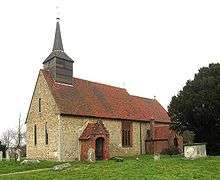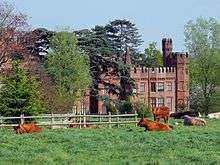Faulkbourne
Faulkbourne is a civil parish in the Braintree district of Essex, about 2 miles (3 km) north-west of Witham. The population at the 2011 Census was included in the civil parish of Fairstead.

According to Faulkbourne's Victorian era rector, the Rev. Frederick Spurrell, the name of the village (which was also spelled "Faulkbourn") is probably derived from the Old English words "falk" or "folc" (meaning "folk") and "burn" (meaning "well").
The parish church, along this those of Fairstead & White Notley are administered by the Rector of Terling.
Faulkbourne Hall

The Manor had been held by Turbin in the time of Edward the Confessor and was given by William the Conqueror to his nephew Haimo whose niece passed the Manor by marriage to Henry I's natural son, Robert, Earl of Gloucester. It subsequently belonged to Richard de Luci, Lord Chief Justice of England and Sheriff of Essex in 1156. In 1243, Richard de Redvers succeeded to the manor.
After passing through several hands, the Manor was left by Sir Thomas Montgomery to his nephew John Fortescue in 1494, whose descendant of the same name sold the Manor to Sir Edward Bullock in 1637. The Bullock family lived at Faulkbourne until the turn of the 20th century, and included Colonel John Bullock, Member of Parliament for several Essex constituencies for 56 years, who made many improvements to the hall. In April 1885, Princess Louise, Duchess of Argyll (Queen Victoria's daughter) stood as sponsor at the christening of a member of the Bullock family.[1][2]
The earliest parts of Faulkbourne Hall, a red-bricked building with turrets, date from the 15th century. The Hall range was aligned NE-SW with a crosswing at NE end in 1439-1449. A range was added to the NW in 1449-1494 together with a square tower at the N corner and a stair turret at its E corner. Substantial additions were made by Sir Edward Bullock in the 17th century. A further wing to SE of the crosswing was added in c. 1693. Further extension was made in the 19th century in the S angle. The Hall is a fine specimen of Early Tudor red brick, listed Grade I.[3] The exterior of the house holds a number of metalled vanes in the form of flags bearing the initials of the Bullock family.
The Church of St Germanus which stands in the park, is Norman containing many memorials to the Bullock family formerly including the helm and pennon-rest of Sir Edward which was stolen in 1969.[4]
Faulkbourne Church
The church, which stands close to Faulkbourne Hall, the former residence of the Bullock family, is dedicated to Germanus of Auxerre[5] and was restored in 1886 by the Rev. Frederick Spurrell, with the assistance of the architect Sir Arthur Blomfield. Rev. Spurrell presented a history of the church to the Essex Archaeological Society on 30 August 1877, a transcript of which can be found in their records. He dates the church as Norman, built towards the end of the reign of William I of England, and suggests that the reason for the building being dedicated to Saint Germanus is probably that it was consecrated on 31 July, his feast day.
List of rectors
Some of the Rectors of Faulkbourne include:
...
Rev. John Harrison (1746-1798)
Rev. John Watson (1798-1818)
Rev. John Bullock (1818-1845)
Rev. Robert Burdett Burgess, M.A. (1845-1847)
Rev. Walter Trevelyan Bullock, M.A. (1847-1853)
Rev. Frederick Spurrell, M.A., A.K.C. (1853-1898)
...
Rev. Canon Francis William Galpin (1921-1933)
...
Rev. John Michael Hall (current Rector of Fairstead with Terling and White Notley with Faulkbourne)
Further reading
For more information on the church, see
A guide to Saint Germanus Church Faulkbourne, (Ed. David Andrews) compiled by the Parochial Church Council (2000), Faulkbourne Press, ISBN 978-0-9538028-1-4
Faulkbourn Church, a paper by the Rev. Frederick Spurrell published in the Essex Archaeological Society Transperiodical (1878)
See also
References
- ↑ Bullock, Llewellyn C W, Memoirs of the Bullock Family, A J Lawrence 1905
- ↑ Bullock, Osmund, Faulkbourne and the Bullocks, 2005
- ↑ "British Listed Buildings".
- ↑ A Guide to Saint Germanus Church Faulkbourne
- ↑ S. Baring-Gould & John Fisher (1911). The Lives of the British Saints.
